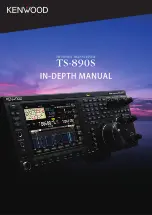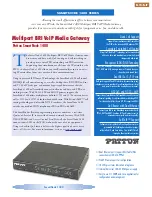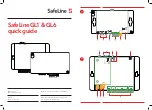
01 PROLOGUE
1
About the Release of the TS‑890S
From the TS-590 that was released in 2010 to the TS-990S in 2013 and TS-590G in 2014, we have been releasing HF
transceivers for Real DX’ers where efforts were devoted to the basic reception performance, and have received very
high ratings for these products. In response to a strong demand for a grade that is positioned between the TS-990S and
TS-590, we started considering the idea of commercializing the TS-800 series.
Previously, popular transceivers that were released under the TS-800 series include advanced, fully-armored units that
can be used in the front line under demanding conditions such as DX contests.
Models such as the TS-820 (released in 1976: IF SHIFT, ARA processor), TS-830 (released in 1980: diverse interference
elimination features), TS-850 (released in 1991: up-conversion) and TS-870 (released in 1995: first amateur transceiver
with IF DSP) have played an active part with each of them equipped with the latest technology of the era. They are still
employed by many of the users today.
The TS-890S, the latest addition to the glorious history of the TS-800 family, has been developed not only to
complement the TS-990S and TS-590 series, but attention has also been devoted to the “basic reception performance”,
which is the main interest of our customers. As a benchmark, we have aimed to develop a design that offers top-class
performance in 3rd Intermodulation Dynamic Range (3rd IMDR), as well as in Reciprocal Mixing Dynamic Range
(RMDR) and Blocking Dynamic Range (BDR).
To achieve this, our initial plan when designing the receiving circuit configuration was to adopt the direct sampling
system in line with the current trend. However, to enable users to make use of the unit without having to worry about the
issue of overflow, we decided to adopt the down-conversion system that allows the use of narrow-band roofing filters. At
the same time, we have also made significant enhancements to the C/N characteristics by developing a new first local
oscillator circuit, which is another key element of superheterodyne down-conversion transceivers, based on the division
type that was adopted on the TS-990S.
Doing so has allowed us to achieve the following values in the measurement: 3rd IMDR (110 dB), RMDR (122 dB), BDR
(150 dB) (measurement when the frequency is 2 kHz detuned, receiving frequency of 14.2 MHz, MODE CW, BW 500
Hz, PRE AMP OFF).
For the IF DSP, which is protected by the impregnable front-end as suggested by these numerical values, we have
developed an original AGC algorithm that enables demodulation of incoming signals using the KENWOOD tone that is
non-tiring even during prolonged operation in contests. Listening to the tone is equivalent to the joy of receiving signals.
However, numerical performance is not the only criterion that determines whether a transceiver can be put into practical
use. Elements related to user-friendliness, such as operability and visibility, are also important considerations.
The same 7-inch color TFT as with the TS-990S has been employed for the bandscope. Feedback from TS-990S users
has been incorporated into a number of aspects. Some of such new features that come in handy particularly during
contest operation include the auto scroll feature in the Fixed mode, straight display for waterfall in the Center mode, and
highlight display for IF passband widths.
The bandscope receiver is configured using an SDR method that enables FFT processing of the entire display span,
thus achieving signal processing at a faster speed compared to the TS-990S. At the same time, the bandscope receiver
separately processes signals diverted from the first mixer for the incoming signal system, and this enables the use of
ATT without affecting the incoming signals.
In terms of operability, we have exercised our ingenuity in the split-operation settings so as to maximize the operational
efficiency during simplex reception via VFO A/B. These creative efforts allow configuration of the split settings using the
long-press of the
[SPLIT]
key and the press of the numeric keypad, band change while retaining the split settings, and
TX VFO operation using the
[RIT/XIT]
knob. Also, connection with an external receiver can be established easily using
the ANT OUT feature. To use the TS-590 series as the external receiver, frequency transfer and standby are possible
simply by connecting two cables.
As with TS-990S, the Digital mode comes with PSK/FSK decoding/encoding features and communication using the
main unit alone is possible by connecting a USB keyboard. Not only so, TS-890S also comes with a decode/encode
feature in the CW mode (only available in western languages). Morse codes can also be transmitted directly from the
keyboard in the CW mode, which enables paddle-less operation.
The transmission output of 100 W is the same as the conventional TS-800 series models, but TS-890S allows for
quiet and stable prolonged use with the employment of a large die-cast chassis and 80 mm x 80 mm twin fan system.
Needless to say, the fans will not operate when only reception is in progress.






































